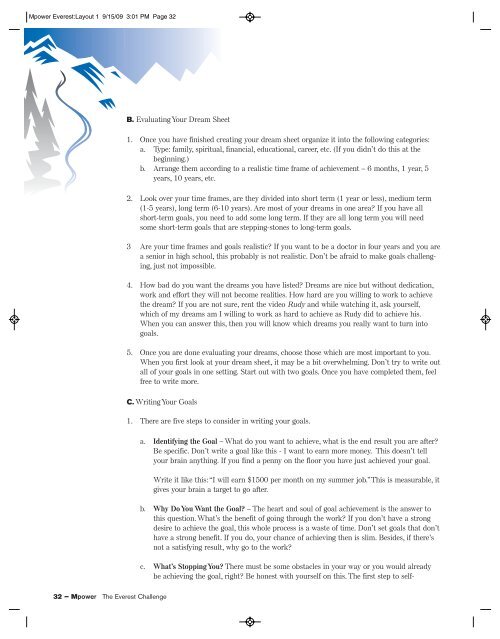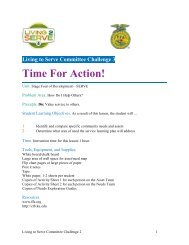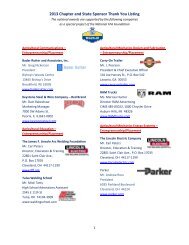The Everest Challenge - National FFA Organization
The Everest Challenge - National FFA Organization
The Everest Challenge - National FFA Organization
You also want an ePaper? Increase the reach of your titles
YUMPU automatically turns print PDFs into web optimized ePapers that Google loves.
Mpower <strong>Everest</strong>:Layout 1 9/15/09 3:01 PM Page 32<br />
B. Evaluating Your Dream Sheet<br />
1. Once you have finished creating your dream sheet organize it into the following categories:<br />
a. Type: family, spiritual, financial, educational, career, etc. (If you didn’t do this at the<br />
beginning.)<br />
b. Arrange them according to a realistic time frame of achievement – 6 months, 1 year, 5<br />
years, 10 years, etc.<br />
2. Look over your time frames, are they divided into short term (1 year or less), medium term<br />
(1-5 years), long term (6-10 years). Are most of your dreams in one area? If you have all<br />
short-term goals, you need to add some long term. If they are all long term you will need<br />
some short-term goals that are stepping-stones to long-term goals.<br />
3 Are your time frames and goals realistic? If you want to be a doctor in four years and you are<br />
a senior in high school, this probably is not realistic. Don’t be afraid to make goals challenging,<br />
just not impossible.<br />
4. How bad do you want the dreams you have listed? Dreams are nice but without dedication,<br />
work and effort they will not become realities. How hard are you willing to work to achieve<br />
the dream? If you are not sure, rent the video Rudy and while watching it, ask yourself,<br />
which of my dreams am I willing to work as hard to achieve as Rudy did to achieve his.<br />
When you can answer this, then you will know which dreams you really want to turn into<br />
goals.<br />
5. Once you are done evaluating your dreams, choose those which are most important to you.<br />
When you first look at your dream sheet, it may be a bit overwhelming. Don’t try to write out<br />
all of your goals in one setting. Start out with two goals. Once you have completed them, feel<br />
free to write more.<br />
C. Writing Your Goals<br />
1. <strong>The</strong>re are five steps to consider in writing your goals.<br />
a. Identifying the Goal – What do you want to achieve, what is the end result you are after?<br />
Be specific. Don’t write a goal like this - I want to earn more money. This doesn’t tell<br />
your brain anything. If you find a penny on the floor you have just achieved your goal.<br />
Write it like this: “I will earn $1500 per month on my summer job.” This is measurable, it<br />
gives your brain a target to go after.<br />
b. Why Do You Want the Goal? – <strong>The</strong> heart and soul of goal achievement is the answer to<br />
this question. What’s the benefit of going through the work? If you don’t have a strong<br />
desire to achieve the goal, this whole process is a waste of time. Don’t set goals that don’t<br />
have a strong benefit. If you do, your chance of achieving then is slim. Besides, if there’s<br />
not a satisfying result, why go to the work?<br />
c. What’s Stopping You? <strong>The</strong>re must be some obstacles in your way or you would already<br />
be achieving the goal, right? Be honest with yourself on this. <strong>The</strong> first step to self-<br />
32 — Mpower <strong>The</strong> <strong>Everest</strong> <strong>Challenge</strong>
















